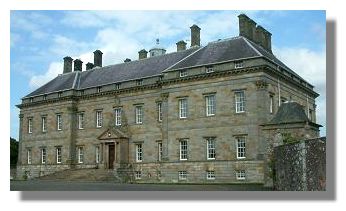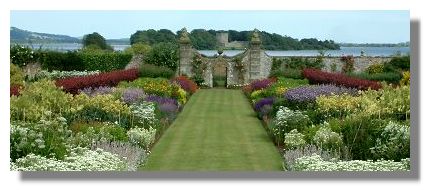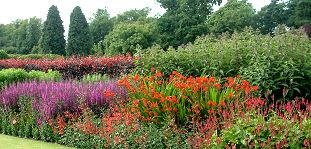
Places to Visit in Scotland
- Kinross House and Gardens

Special Note
Due to major renovation work being done inside Kinross House and buildings in the grounds, and for Health & Safety reasons related to that, the grounds will not be open to the public in 2011 and for at least the first half of 2012.Kinross House
The estate on which Kinross House stands was originally owned by the Earl of Morton but in 1675 it was bought by Sir William Bruce (1630 - 1710). Bruce had been a major player in the restoration of King Charles II to the throne in 1660 and that no doubt helped his career as an architect - not of monarchy, but of buildings. He was appointed a baronet in 1668 and became "surveyor of the king's works" in Scotland. He was responsible for rebuilding the Palace of Holyrood House in Edinburgh (in anticipation of a visit by King Charles II which never materialised) as well as for major works at Hopetoun House, Thirlestane Castle and Balcaskie Castle and Wemyss Hall (later largely demolished and rebuilt as Hill of Tarvit Mansionhouse ).
Bruce was so busy working on commissions that progress on his own house was slow. Having purchased the estate in 1675, he didn't begin designing the gardens until 1679 - and then took six years completing that task. He didn't start building Kinross House until 1685. It rose to four storeys and with a wide wall on each side; people approaching from the town of Kinross would be unaware that the other side of the house has a magnificent garden and a view over Loch Leven. The stone carving above the entrance (seen here) was undertaken by two Dutch carvers.
When the House of Stuart lost the throne and William of Orange took over, Bruce continued to be loyal to the Stuarts. He was imprisoned on three occasions for his hostility to the new regime. That did not seem to affect his architectural commissions, however, and his many works prompted some to call him the "Christopher Wren of Scotland."
Kinross House later came into the possession of Sir James Montgomery of Stanhope in 1820. However, the Montgomerys preferred to live at Stobo Castle in the Scottish Borders. It was not until 1902 that Sir Basil Montgomery decided to live in the house again and to restore the gardens, which had in the meantime become derelict.
The Montgomerys still live in the house and although the gardens are open to the public, the inside of the house is private.
The View Over Loch Leven
When Sir James Bruce designed his own house at Kinross, he spent a great deal of time on planning the garden and, of course, the view from the house over loch Leven to Loch Leven Castle where Mary Queen of Scots had been imprisoned in 1567. Earlier, she had a fierce debate in the great hall of the castle with John Knox, the Protestant religious reformer, as to whether Roman Catholics (she was one) should be persecuted or tolerated. 
As a staunch supporter of the Stuart monarchs (and as an Episcopalian, a form of worship which was often attacked by the Presbyterians in Scotland), Bruce would be well aware of the historical significance of the castle, quite apart from the aesthetic qualities of such a magnificent view.
The Gardens

The gardens designed by Bruce were in the formal Franco Dutch style which was popular in his day. There were terraces, parterres and orchards and by 1700 he and his son had planted 100,000 oak, ash, elm and Scots pine. A chestnut tree still standing in the garden is thought to be an original one.The gardens we see today are largely what Sir Basil Montgomery recreated when he took up residence in 1902 - although the terraces and the glorious view of Loch Leven and its castle still remain. There are secluded gardens to the left and right of the house as well as the broad sweep down to the loch.
While there are flowering apple and cherry trees and bulbs in spring, there is no doubt that the garden is at its best in the summer when the broad herbaceous borders are a riot of colour, with the yew hedges providing a backdrop. There are borders all round the perimeter of the grounds as well as the long corridor down from the house, so there is plenty of opportunity for a succession of flowers during the summer months.
How to Get There

Kinross is just off the M90 Motorway, which runs from the Forth Road Bridge to Perth. Leave at junction 6 and follow the signs into Kinross itself. When you reach the T-junction in the town, turn right. There is then a sign for Kinross House at the first road on the left. As you can see from the illustration above, the approach to Kinross House is impressive.The gardens are open from May to September from 2pm to 7pm every day. Kinross House itself is not open to the public.
See also the Location Map (you can enlarge the scale of this map, if required).
Return to Index of Places to Visit
Where else would you like to go in Scotland?

